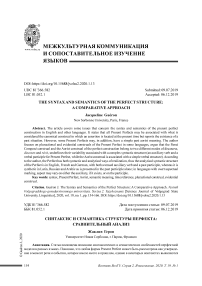The syntax and semantics of the perfect structure: a comparative approach
Автор: Guron Jacqueline
Журнал: Вестник Волгоградского государственного университета. Серия 2: Языкознание @jvolsu-linguistics
Рубрика: Межкультурная коммуникация и сопоставительное изучение языков
Статья в выпуске: 1 т.19, 2020 года.
Бесплатный доступ
The article covers some issues that concern the syntax and semantics of the present perfect construction in English and other languages. It states that all Present Perfects may be associated with what is considered the canonical construal in which an assertion is located at the present time but reports the existence of a past situation. However, some Present Perfects may, in addition, have a simple past aorist meaning. The author focuses on pluractional and evidential construals of the Present Perfect in some languages, argue that the Passé Composé construal and the Aorist construal of the perfect construction belong to two different modes of discourse, discours and récit , underlines their variability associated with a complex syntactic structure (an auxiliaryverb and a verbal participle for Present Perfect, while the Aorist construal is associated with a simple verbal structure). According to the author, the Perfect has both syntactic and analytical ways of realization, thus the analytical syntactic structure of the Perfect is in English, French and German, with both a tensed auxiliaryverb and a past participle, whereas it is synthetic in Latin, Russian and Arabic as is presented in the past participle alone; in languages with overt aspectual marking, aspect mayvaryon either the auxiliary, if it exists, or on the participle.
Syntax, present perfect, aorist, semantic meaning, time reference, pluractional construal, evidential construal
Короткий адрес: https://sciup.org/149131535
IDR: 149131535 | DOI: 10.15688/jvolsu2.2020.1.13
Список литературы The syntax and semantics of the perfect structure: a comparative approach
- Baptista M., Guéron J., 2014. Sobre tempo e aspecto em Portugués: comparando a PB ao PE. MouraD., Sibaldo M.A., eds. Sintaxe comparativa entre o Portugués brasileiro e línguas crioulas de base lexical portuguesa. Vol. III, Cap. 8. Maceió, Edufal. Benveniste E., 1966. Problèmes de linguistique
- Générale. T. 1. Paris, Gallimard. 286 p. Chomsky N., 1995. The Minimalist Program.
- Cambridge, MA, MIT Press. 420 p. Comrie B., 1976. Tense. Cambridge, Cambridge
- University Press. 142 p. Fassi Fehri A., 2012. Arabic Perfect and Temporal Adverbs. Alexiadou A., Rathert M., Stechow A. von, eds. Perfect Explorations. Berlin, De Gruyter, pp. 69-99
- Freeze R., 1992. Existentials and Other Locatives. Language, vol. 68, iss. 3, pp. 553-595.
- Giorgi A., Pianesi F., 1997. Tense and Aspect. From Semantics to Morphosyntax. New York, Oxford, Oxford University Press. 319 p.
- Guéron J., 2004. Tense Interpretation and the Argument Structure of Auxiliaries. Guéron J., Lecarme J., eds. The Syntax of Time. Cambridge, MA, MIT Press, pp. 299-328.
- Guéron J., Hoekstra T., 1988. T-Chains and the Constituent Structure of Auxiliaries. Cardinaletti A., Cinque G, Giusti G., eds. Proceedings of the GLOW Conference in Venice 1987. Dordrecht, Foris, pp. 35-99.
- Hoekstra T., 1984. Transitivity: Grammatical Relations in Government-Binding Theory. Dordrecht, Foris. 311 p.
- Iatridou S., 2000. The Grammatical Ingredients of Counterfactuality. Linguistic Inquiry, vol. 31, no. 2, pp. 231-270.
- Iatridou S., Anagnostopoulu E., Izvorski R., 2001. Some Observations About the Form and Meaning of the Perfect. Kenstowicz M., ed. Ken Hale: A Life in Language. Cambridge, MA, MIT Press, pp. 189-238.
- Ilari R., 2001. Notas sobre o passado composto em portugues. RevistaLetras, num. 55, pp. 129-152.
- Izvorski R., 1997. The Present Perfect as an Epistemic Modal. Lawson A., Choe E., eds. SALT 7, pp. 133147. URL: https://pdfs.semanticscholar.org/ d4e5/dac02b2361c186ede4bf89fbd1dca 6019a48.pdf.
- Kayne R., 1975. French Syntax: The Transformational Cycle. Cambridge, MA, MIT Press. 473 p.
- Kayne R., 2000. Toward a Modular Theory of Auxiliary Selection. Parameters and Universals. Oxford, Oxford University Press, pp. 107-130
- Kiparsky P., 2002. The Polysemy of the Perfect. Beaver D., Casillas Martinez L., Clarck B., Kaufmann S., eds. The Construction of Meaning. Stanford, CSLI Publications, pp. 113-135.
- Klein W., 1992. The Present Perfect Puzzle. Language, vol. 68, pp. 525-552.
- Kratzer A., 2012. Modality and Conditionals. Oxford, Oxford University Press. 203 p.
- Laca B., Cabredo-Hofherr P., Carvalho S. de, 2010. When Perfect Means Plural: The Present Perfect in Northeastern Brazilian Portuguese Varieties. Cabredo-Hofherr P., Laca B., eds. Layersof Aspect. Stanford, CSLI Publications, pp. 67-100.
- Lyons J., 1968. Introduction to Theoretical Linguistics. Cambridge, Cambridge University Press. 519 p.
- McCoard R.W., 1978. The English Perfect: Tense Choice and Pragmatic Inferences. Amsterdam, North Holland Press. 279 p. Michaelis L., 1994. The Ambiguity of the English Present Perfect. Journal of Linguistics, vol. 30, pp. 111-157.
- Mittwoch A., 1988. Aspects of English Aspect: On the Interaction of Perfect, Progressive and Durational Phrases. Linguistics and Philosophy, vol. 11, pp. 203-225. Pancheva R., Stechow A. von, 2004. On the Present Perfect Puzzle. Moulton K., Wolf M., eds. NELS34, pp. 469-484. Partee B., 1973. Some Structural Analogies Between Pronouns and Tenses in English. Journal of Philosophy, no. 70, pp. 601-609. Alexiadou A., Rathert M., Stechow A. von, eds., 2012.
- Perfect Explorations. Berlin, De Gruyter. 442 p. Portner P., 2003. The Temporal Semantics and Modal Pragmatics of the Perfect. Linguistics and Philosophy, no. 26, pp. 459-510. Schmitt C., 2001. Cross-Linguistic Variation and the Present Perfect: The Case of Portuguese. Natural Language and Linguistic Theory, no. 19, pp. 403-453. Smith C., 1997. The Parameter of Aspect. Dordrecht, Kluwer. 469 p. Smith C., 2007. Tense and Temporal Interpretation.
- Lingua, vol. 117, iss. 2, pp. 419-436. Tilkov D., Stoyanov S., Popov K., 1983. Gramatika na suvremennia bulgarski knizoven ezik. Sofia, BAN. 511 p.


